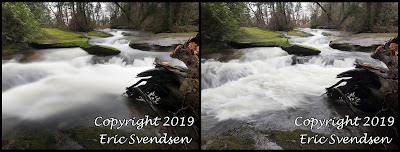 |
| Millstone creek, Nanaimo |
The two photos above were both shot with a camera mounted on top of a tripod. A tripod was necessary due to the slow shutter speed used on each picture. The one on the right was already modestly slow, being only 1/6th of a second. It shows some blurring of the water but nothing like the image on the left. It was photographed at a full 15 seconds.
The difference is stunning; things that are not moving have not been affected at all - part of the reason for the tripod. The water shows a vast difference. Longer shutter speeds produce greater degrees of blur. It is possible to go too long, as eventually all distinction would be lost in the moving water. The length of time chosen and the resulting effects are based upon a great many things. How close the camera is to the water, how fast the water is moving, and how much water there is are all factors. I often find that 5 seconds is long enough; I wanted this one to be longer to really show the impact of slow shutter speeds.
There is another thing going on which won't be noticed unless you really understand the nature of light and the camera. There is no way that a 15 second shutter speed is possible during a normal day. There is just too much light present. The aperture for the right image was f/11 and for the left was f/16. ISO was unchanged. There is only 1 stop difference in aperture, but about 6 1/2 stops difference between shutter speeds. How is this done?
The answer is a neutral density filter. A N.D. filter is a darkened filter which allows the photographer to use slower shutter speeds than otherwise possible. The one used was a variable neutral density filter, whose values can be changed from 1 stop to 10 stops. The result was to allow the camera to shoot at a very much reduced shutter speed. These are especially handy on bright days when you just can't get the speed down.
No comments:
Post a Comment